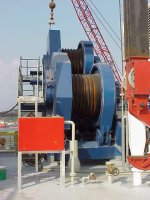My apologigies, however...
Throughout the far reaches of the Universe, there is no greater Force than the Urge to Edit !!!
A couple more paragraphs would have been nice...
First, I need to say that I have worked on this type of boom system when I was in the Navy. That was before micro-chips had more than a few hundred transistors on them. Much of the control was more often by-hand than by automatic control - simply because the "automatic" systems were always failing.
shelnian said...
I have just been given the job to come up with a control system for a hydraulic winch assembly containing two hydraulic traction winch motors and one storage winch motor. This system will be operated on a ship at sea. Each motor is controlled by two servo valves with 0-20mA inputs and dual LVDTs and delta pressure feedback transducers for redundancy.
The storage winch motor uses delta pressure control and traction winch bias to maintain 1500 + or - 500LB tension on the cable at the storage drum.
The traction winches have to handle 4 modes of operation.
- Mode-1: Velocity of Reel-In and Reel-Out NOT to exceed 2 ft/sec.
- Mode-2: Velocity of Reel-In and Reel-Out NOT to exceed 4 ft/sec.
- Mode-3: Automatic Mode (Position) - Automatic Reel-In and Reel-Out to Maintain constant position. Position feedback to be provided by a sensor on the end of the cable.
- Mode-4: Automatic Mode (Traction Outhaul Tension) - Maintain a constant tension on the traction winch outhaul cable during deckside operations.
At no time may the system accelleration exceed 1 ft/sec2.
The system is moving a fairly heavy load up to 30kLBs. The system has blocking valves in front of each servo valve and a whole array of interlocks to ensure the system can not be operated before all required conditions are true.
The traction winch motors can be operated in full or half displacement that is controlled by another set of valves.
The whole system needs to be controlled from a Windows 2000 Operator interface and joystick for the NON-Automatic modes.
The system should have enough redundancy (dual control systems with automatic system control transfer) so that the package on the end of the cable can be recovered.
Each control loop will need up to four PIDs to meet system operational requirements outlined above based on what the hydraulic engineer has told me.
The interface between the Windows 2000 PC and the control system is a 10/100 BaseT ethernet.
My Question is,
Can a PLC or multi PLC system handle this level of complexity or should I be using a PC/VME to control this system?
I have never used PLCs and do not have a good feel for what level of complexity they can handle. However, what I have read lately sounds encouraging.
My response...
OPERATIONAL SPECIFICATIONS
The specifications you need to meet are well within the capabilities of most mid-level PLC's.
PROGRAM DEVELOPMENT AND PROGRAMMING
Are you looking to develop the program yourself? Or, are you planning on contracting the work out?
If you plan to develop the program yourself, then the ultimate "decider" is your ability. Do you know how to develop a program? Do you know how to program a PLC? Do you have any programming experience at all?
REDUNDANCY
You can have several PLC's running at the same time, all running the same program and watching all of the same inputs. Only one of the PLC's would actually be controlling the outputs.
The PLC's can be arranged using a "Voting" method... that is, a certain number of PLC's have to agree on what should happen. If any PLC is consistently seen to be out of agreement then that PLC would be taken Off-Line.
The PLC's could be arranged using an "Expected vs. Actual" evaluation... that is, if the response you detect does not match (within certain limits) the response you expect then that PLC would be taken Off-Line and the back-up brought On-line. The transfer would be seamless.
At some point, you are bound to run into a mechanical failure. This failure might simply result in poor response, or it might be a catastrophic failure. Having redundant hardware certainly makes the entire system more fault tolerant.
Depending on how "SMART" the program is, it might be able to determine if the failure is in the PLC or in the hardware. It might simply switch out the failing component (PLC or hardware), or, you could simply switch from one PLC/Hardware System to the other.
You can check out the failure later when you're not trying to keep 30klbs from swinging into the side of the ship.
You should also probably make provisions for a complete failure of the automatic system... that is, have a COMPLETE MANUAL SYSTEM in stand-by. However, be aware, you can take this redundancy stuff only so far.
You should be able to find a number of Windows based systems for monitoring and controlling the PLC's. That system should be able to monitor ALL of the PLC's at the same time. Use the Windows program recommended by the the particular PLC Manufacturer that you choose - don't try to use one that is not specifically recommended.
I'd like to hear what you finally decide on using. Keep us posted.
I now see that Peter has posted. He certainly makes some valid points in terms of a highly responsive system.
The question is...
What kind of response do you really need?
Any PLC will have a certain minimum scan time. The length of the program will have a direct impact on the total time. The smaller the program, the more chance the PLC has to produce a proper and timely response. And, of course, installing modules that monitor and control specific PLC-commanded effects only helps.
Remember, this particular process was handled MANUALLY, once upon a time.






